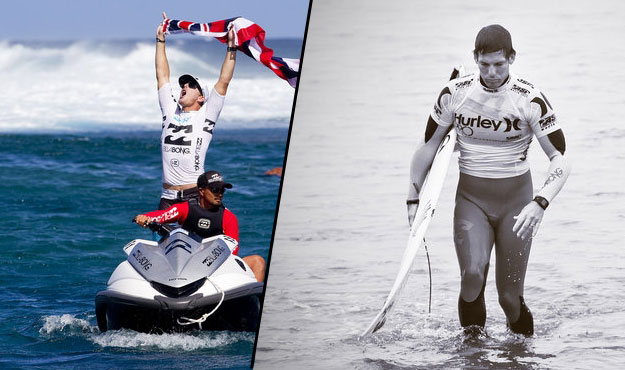
In life, Irons’ rock star combination of savant surfing and personal brashness polarized the surf community like few others, so it’s grimly fitting that his death should do the same. Photos: ASP/Robbo/Rowland
On Friday, June 10th the Tarrant County Medical Examiner’s office released the toxicology report for Philip Andrew “Andy” Irons. It states that his primary cause of death was a sudden cardiac arrest associated with coronary artery disease with a 70-80% stenosis (abnormal narrowing) of one of his arteries. It further states that his secondary cause of death was “acute mixed drug ingestion.” According to the report, the following drugs were found either on his person or in his system: Alprazolam, (Xanax) Zolpidem, (Ambien), cannabinoids (marijuana) naproxen (anti-inflammatory), cocaethylene (a chemical produced in the body when cocaine and alcohol are mixed that’s linked to causing heart attacks in people under forty), methamphetamine, methadone, and cocaine. The report includes a lengthy “comments” section explaining how cocaine and methadone can impede the work of the heart – thereby making their presence in Irons’ body “significant.” It concludes with the following: “the primary and underlying cause of death is ischemic heart disease due to coronary artery pathology (heart disease). Drugs however, particularly, methadone and cocaine, are other significant conditions contributing to death but not resulting in the underlying cause.”
Some, like Dr. Vincent Di Maio, an award-winning forensic expert and media stalwart hired by the Irons family, believe that drugs did not contribute to Irons’ death. Others, like the numerous doctors anecdotally consulted for this piece, side with the Medical examiners in Tarrant County citing the myriad and well-documented ways that prolonged drug use can debilitate the heart. In life, Irons’ rock star combination of savant surfing and personal brashness polarized the surfing community like few other public figures, so it is grimly fitting that his death should do the same.
The premature death of a famous and monetarily influential person is always a tragedy, but never just a tragedy. It is many things to many people: a PR nightmare, the scoop of a lifetime, an inconvenience for a tour that seeks legitimacy, the instant canonization of his legend, a damning comment on celebrity culture, a cautionary tale, the tragic loss of a father, brother, husband and son, an ode to self destruction, an episode better left forgotten, an opportunity to change.
What makes Irons unique is not that he self destructed; it’s that he did so in full view of his sponsors, the media, and his fans – while he was still one of the best surfers in the world. His story presents an interesting study in the way the surfing world, and action sports cultures in general, function as they mature into full-blown consumer industries.
Perhaps the most telling aspect of the way Irons’ death has been officially handled is the pregnant silence and, in some cases, apparent misdirection that has come from those in a position to clarify incongruous facts and events surrounding his death. A Billabong Executive declined to comment on the record for this story, and the day Irons was discovered dead in a Texas hotel room, Billabong’s Director of Media (who may have been acting independently on behalf of the family – it was unclear at time of reporting) distributed the following press release, titled “3-Time World Champ Andy Irons Dead From Deng (sic) Fever” to journalists involved in the surf world:
HONOLULU – (November 2, 2010) — The world of surfing mourns an incredibly sad loss today with the news that Hawaii’s Andy Irons has died. Andy was a beloved husband, and a true champion. Irons, 32, withdrew from a professional surfing event in Puerto Rico last weekend due to illness and passed away during a layover en-route to his home in Kauai, Hawaii. He had reportedly been battling with dengue fever, a viral disease. At this time the family thanks his friends and fans for their support, and asks that the community respect its privacy. The family also asks to not be contacted so their focus can remain on one another during this time of profound loss.
Media outlets diffused the Dengue fever hypothesis until Brad Melekian published his now-famous article in Outside Magazine stating that Irons was apparently well enough to stop in Miami and party with friends. The toxicology report rules out Dengue entirely. It is still unclear who, if anyone, diagnosed Irons in Puerto Rico. Billabong Media representatives have not responded to repeated interview requests, and in December ASP officials refused to pass along contact details for the medical staff that allegedly diagnosed the disease.
A few weeks before the toxicology report was released to the media, I interviewed ex-pro surfer Christian Fletcher whose career, like Irons’ was marked by equal parts brilliance and self-destruction. His take is unequivocal: “Let’s say it comes out that he did have this drug or that drug in his system. If that is the case, they really did try to do a big cover up,” he says.
He then pauses and asks rhetorically: “What the fuck were they lying for? You can create a positive from such a shitty thing happening. If you have a problem like that and you came out and released a statement about it, there wouldn’t have to be people like you calling people like me to get dirt on the situation.”
***

